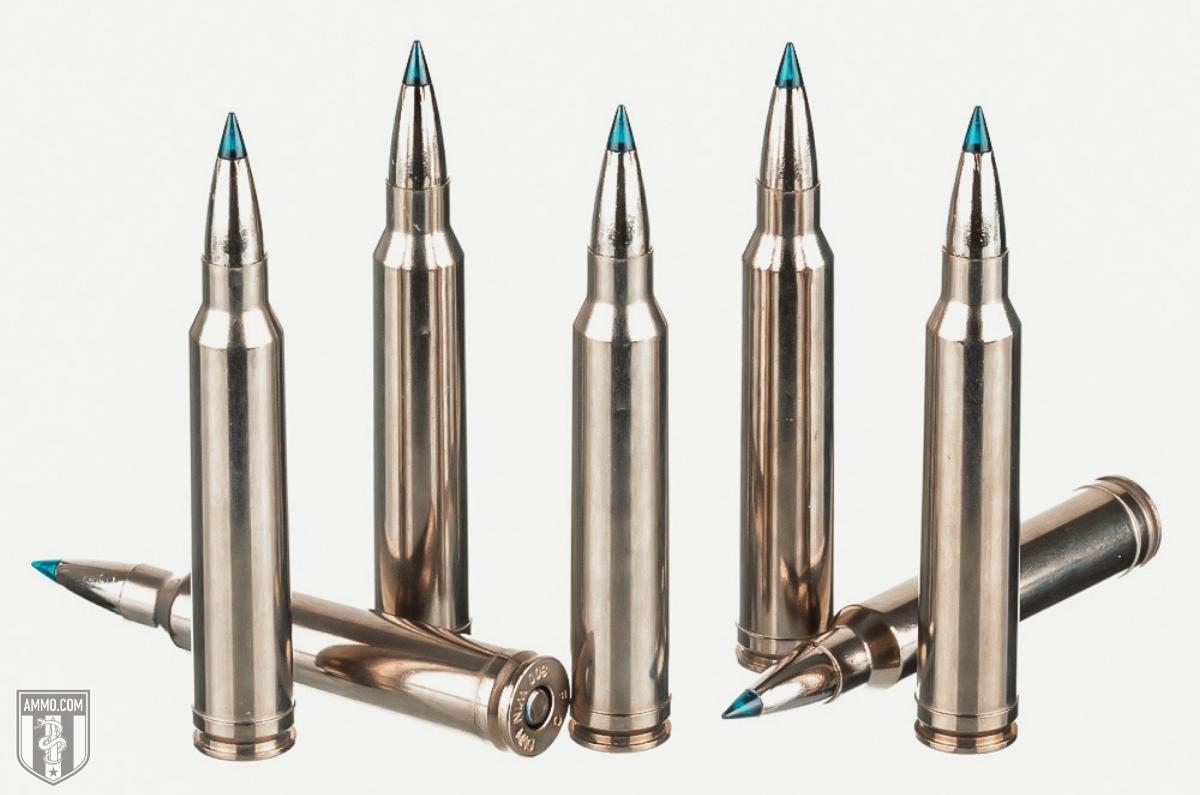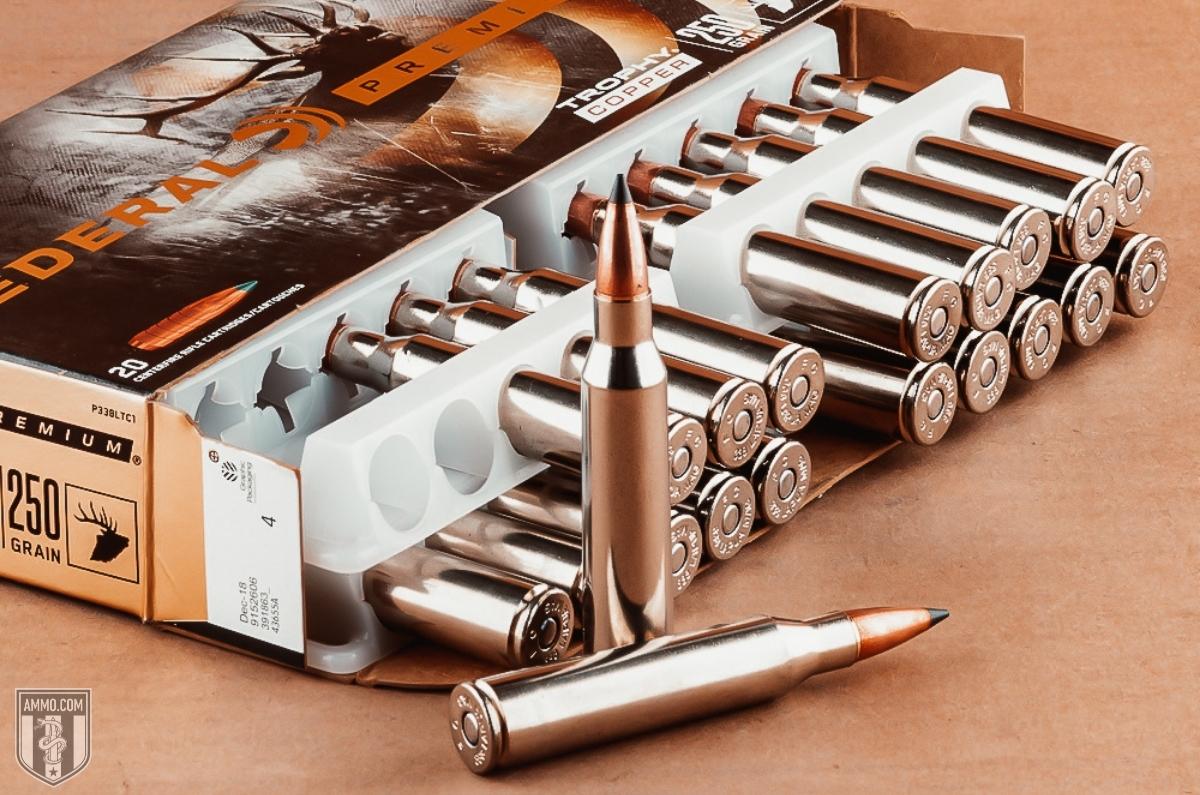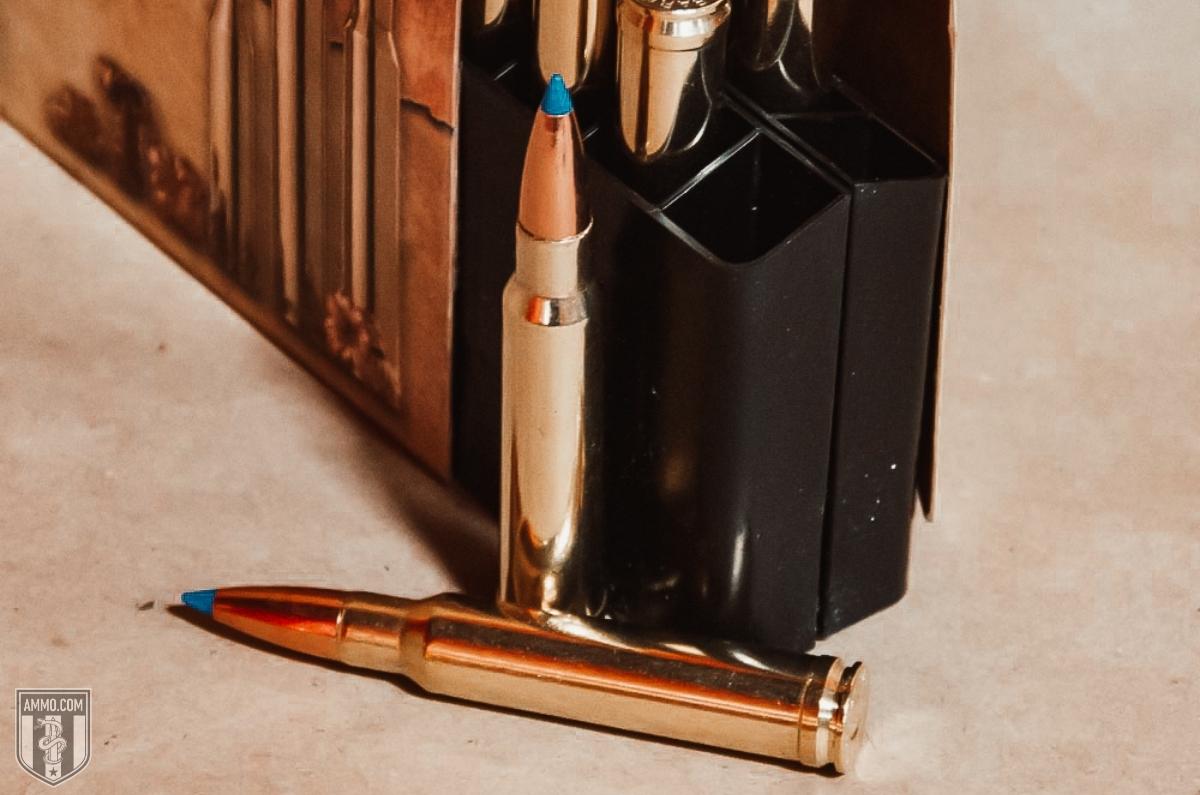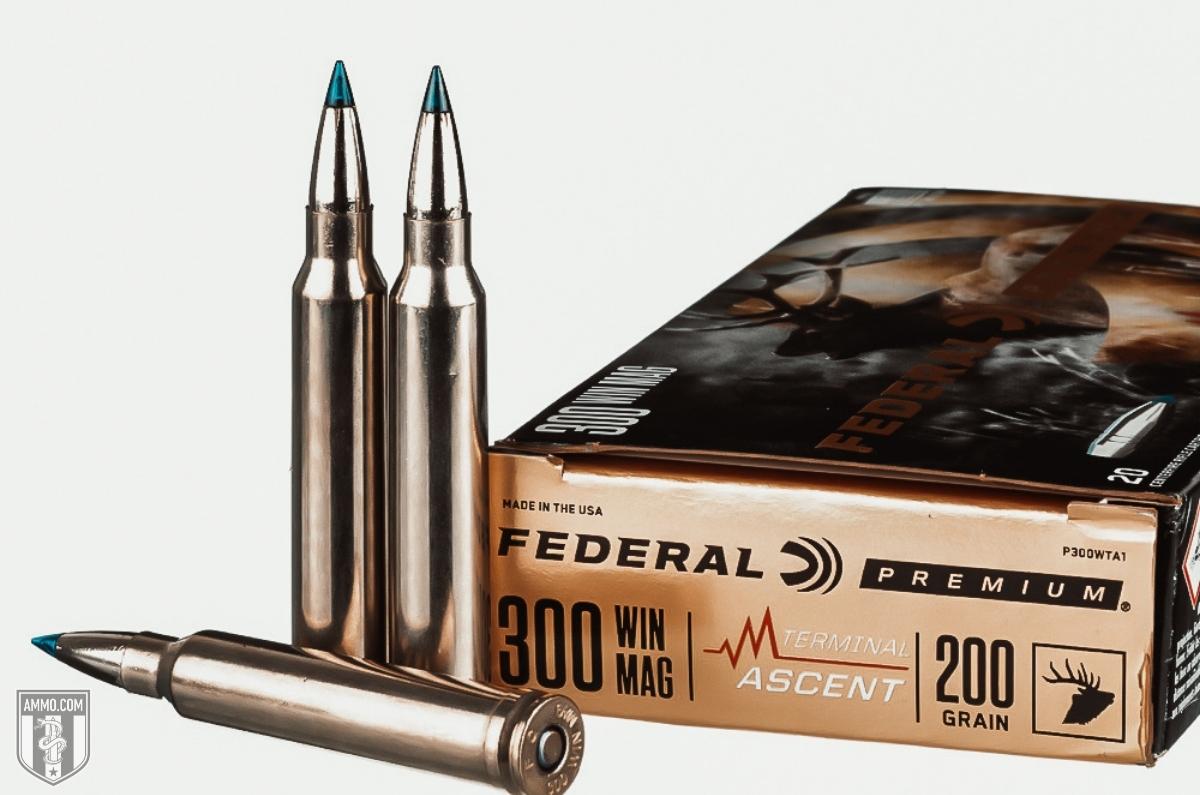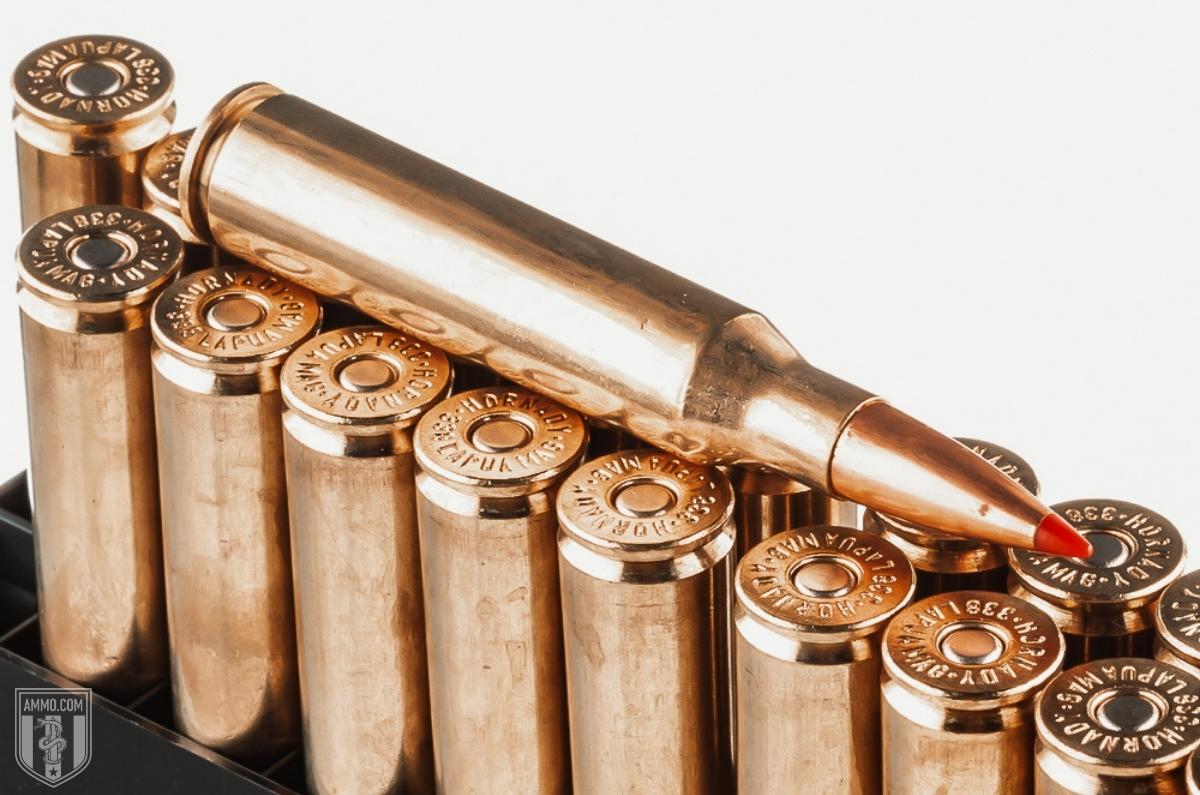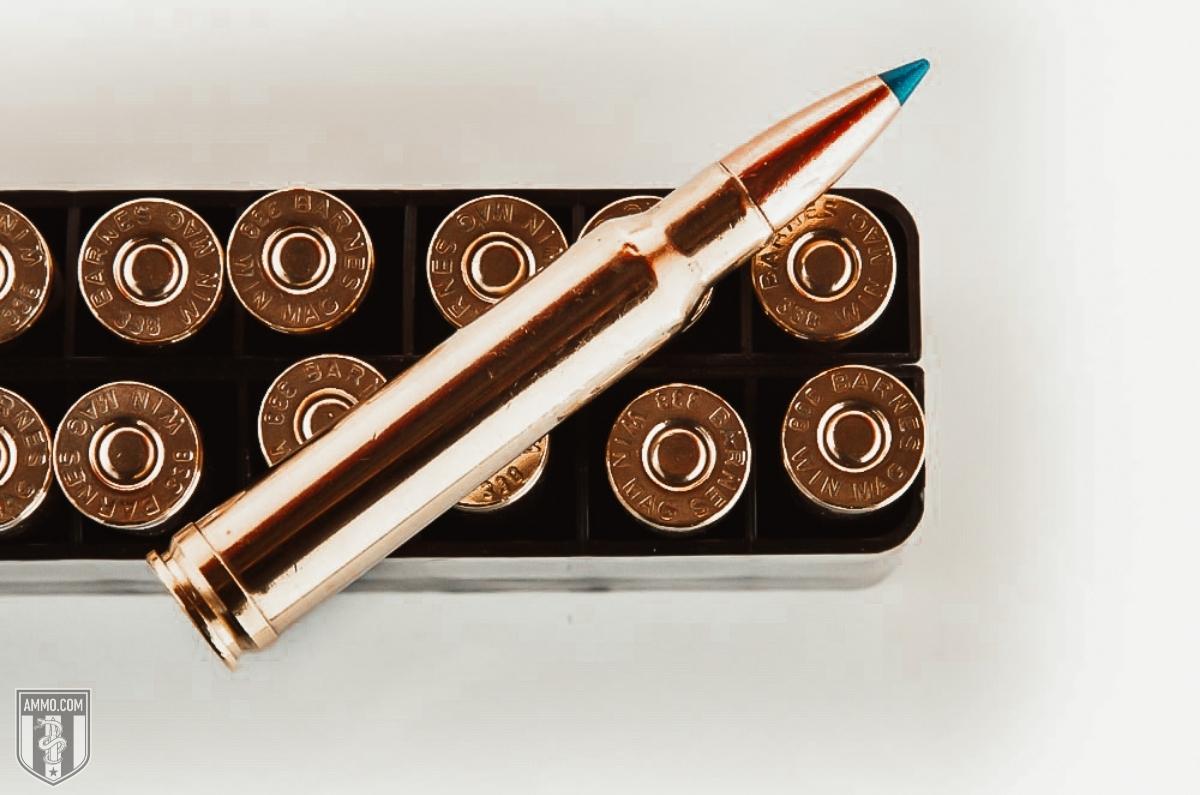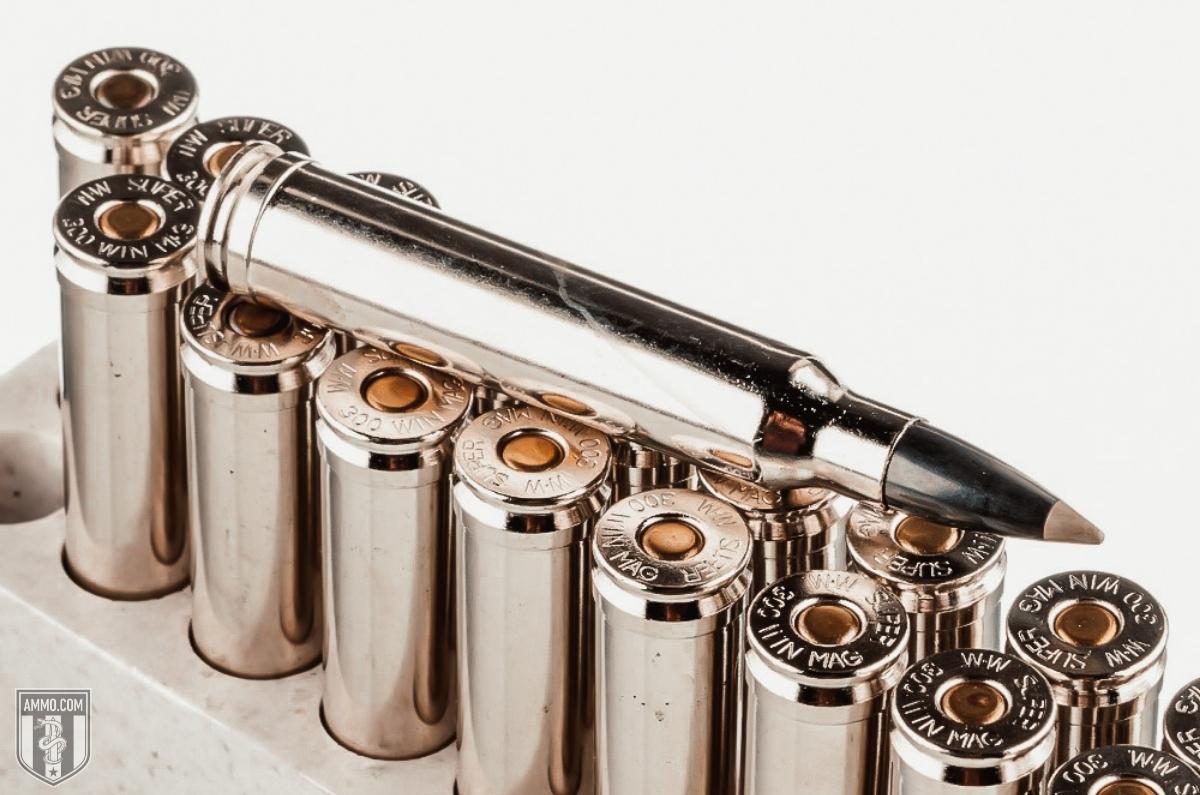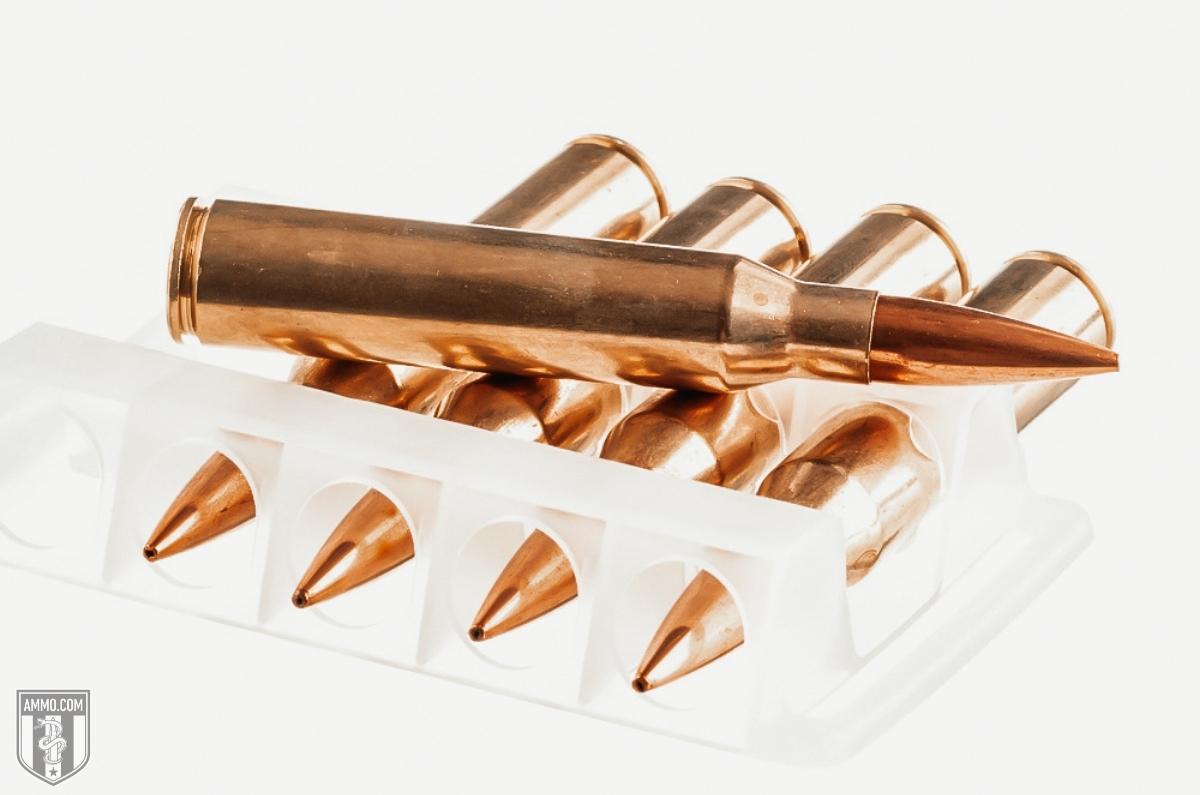300 Win Mag vs 338 Win Mag vs 338 Lapua Mag: It’s Magnum Time
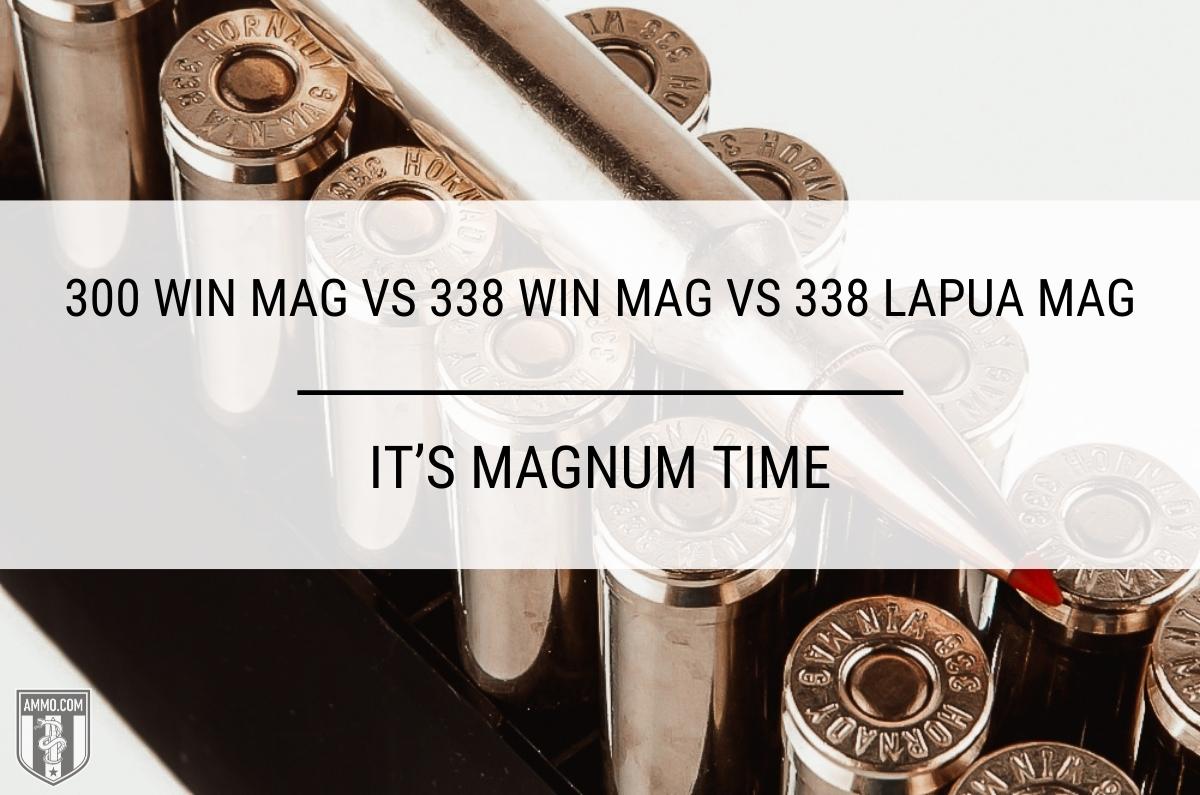
When it comes to putting down large game at longer ranges, most hunters will agree that the 300 Winchester Magnum, 338 Win Mag, and 338 Lapua Magnum are more than up to the task. They all have a relatively flat trajectory and carry enough kinetic energy to get the job done on North American big game like mule deer, elk, moose, and bears.
However, the ballisticians at Winchester and Lapua had different ideas surrounding the intended use of each cartridge and optimized certain aspects of each round to meet those goals. These differences can lead to confusion amongst new shooters as to which cartridge is best for their new hunting rifle.
In this article, we will discuss the merits and shortcomings of the 300 Win Mag, 338 Win Mag and 338 Lapua Mag and provide a clearer picture of how each cartridge fits into your shooting needs.
Cartridge Specs
When evaluating centerfire rifle cartridges, it’s a good idea to analyze the cartridge specs to gain more knowledge of each.
The 300 Win Mag (300 WM) and 338 Win Mag (338 WM) both descend from the 375 H&H Magnum cartridge, although the 338 came out a full 5 years before the introduction of the 300 WM in 1963. In contrast, the 338 Lapua Magnum descends from the older 416 Rigby case, which was originally an African big game cartridge propelled using cordite.
From a visual standpoint, it’s easy to spot the differences between these three cartridges as the 338 Lapua Magnum is considerably larger than the 300 and 338 Win Mag. The 300 Win Mag has a case length of 2.62”, 2.50” for the 338 Win Mag, and 2.724” for the Lapua. The 338 Lapua is also a wider with a base diameter of 0.587” compared to 0.513” for both the 300 and 338 Win Mag.
Another visual distinction between the three rifle cartridges is that the Winchester rounds retain their belt around the base of the case while the 338 Lapua is a beltless cartridge. The belted case is more of a marketing strategy than a practical measure, as it harkens back to the 375 H&H Magnum’s design and is visually recognizable. However, neither the 300 Win Mag nor 338 Win Mag exert pressures that require the use of a case belt.

The 300 Win Mag and 338 Win Mag both have the same overall length of 3.34” as they were designed to fit in a standard/long action rifle while the 338 Lapua has an overall length of 3.681” as it was designed to fit in a longer and bulkier magnum action.
The difference in case length and base diameter directly affects the case capacity for each cartridge. As I’m sure you can probably guess, the 338 Lapua Magnum simply dominates in case capacity at 114.2 gr, while the 300 Win Mag has a respectable 93.8 gr of capacity, and lastly 86 gr for the 338 Win Mag.
Another striking difference between these three rounds are the bullets that each cartridge fires. The 300 Win Mag fires the tired-and-true 0.308” diameter bullet that is also used in the 30-06 Springfield and 308 Winchester. On the other hand, the 338 Win Mag and 338 Lapua Mag both fire the larger 0.338” diameter bullets.
The 300 Win Mag typically fires bullets between 150 and 230 grains, with the 150, 165, 180, and 200 grain bullets being the most popular. The 338 Lapua and 338 Win Mag fire the same 0.338” caliber bullet, but the Lapua can fire heavier bullets thanks to its increased case capacity. It is rare to find 338 Win Mag offered in anything heavier than 250 gr, though 225 gr projectiles are also popular. The mighty 338 Lapua is most frequently loaded with a 300-grain bullet, though 285 gr and 270 grain bullets are also popular.
Finally, the 300 Win Mag and 338 Win Mag are both rated for 64,000 psi of pressure per SAAMI specs. The max pressure for the 338 Lapua has been left somewhat ambiguous per CIP guidelines. Most cartridge experts consider the maximum pressure for the 338 Lapua somewhere between 60,000 and 64,000 psi. However, if you plan to handload for the Lapua, simply follow the instructions in your reloading manual and you should be well within specs.
Muzzle Velocity, Kinetic Energy, and Trajectory
All three of these rounds are well-known for being flat shooting with excellent down range performance. To compare these rifle cartridges, we’ve selected 6 different factory loads to analyze.
For the 300 Winchester Magnum, the Federal Premium 180gr Barnes TSX and Hornady 200gr ELD-X, for 338 Winchester Magnum, the Hornady 230gr ELD-X and Nosler 250gr Partition, and for the 338 Lapua Magnum, the Berger 250gr Match and Nosler 300gr AccuBond.
Perhaps the most surprising data point is the differences in trajectory. Excluding the 338 Win Mag 250gr Nosler Partition, the other 5 bullets were all within a little over a foot of each other. Therefore, within normal hunting ranges, all three cartridges are relatively equivalent in terms of bullet drop.
The differences in trajectory become more apparent the further down range you go, as the 338 Lapua’s flatter trajectory really shines past 1,000 yards. For example, the 200 gr ELD-X for 300 Win Mag will have -294.4” of bullet drop at 1,000 yards compared to -242.6” for the 250gr Berger 338 Lapua round. A 1,000 yard shot is not within ethical hunting ranges, but this example illustrates why the 338 Lapua Magnum is often used for long range shooting competitions as it is incredibly flat shooting at longer ranges.
Although the muzzle velocity numbers were not incredibly dissimilar, one impressive thing to note is that the 338 Lapua can push heavier bullets at the same velocities that the other two rounds do with lighter bullets. The 250 gr Berger load for 338 Lapua leads the pack at 3005 fps while the slowest of the bunch was the 338 Win Mag at 2600 fps.
The biggest difference between these three rounds is their muzzle velocity. The 300 Win Mag and 338 Win Mag are impressive in terms of kinetic energy, but the 338 Lapua is a massive step up when it comes to muzzle energy. For example, the 338 Lapua Berger 250gr Match bullet has the same kinetic energy at 500 yards, 3061 ft-lbs, as the 300 Win Mag 180gr TSX has at 100 yards, 3028 ft-lbs.
There’s no denying the 338 Lapua packs on the kinetic energy and can retain it more efficiently at longer ranges, but there’s a price to be paid for that performance.
Recoil
Although the 338 Lapua has amazing ballistics and is incredibly flat shooting, it pays for these advantages in free recoil.
None of these magnum cartridges are known for having light recoil, but as the 300 Win Mag fires lighter bullets, it will typically have less recoil than both 338 rounds.
Felt recoil will vary from shooter to shooter, but free recoil and velocity are a general measure of how hard a cartridge kicks. Recoil is dependent on powder charge, bullet weight, muzzle velocity, and rifle weight.
In the table below we compare the three hunting loads we analyzed in the previous section. The rifles selected were the Weatherby Mark V Accumark (8.3 lbs rifle weight) for 300 Win Mag and 338 Lapua and the Savage 110 Bear Hunter (8.5 lbs rifle weight) for 338 Win Mag. Also included for the 338 Lapua are heavier target rifles like the Ruger Precision Rifle, Barret MRAD, and Savage 110 Elite Precision which all weigh 15 lbs on average.
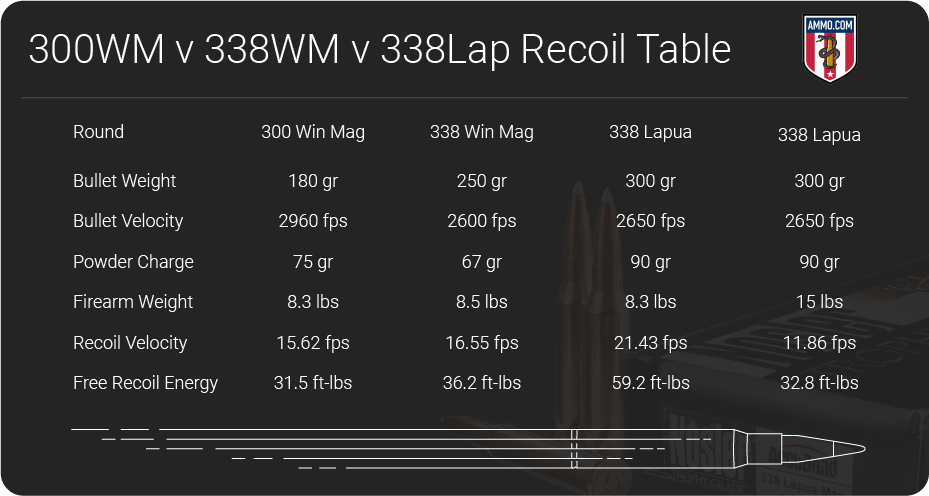
As you can see, the 300 Win Mag has the lowest free recoil at 31.5 ft-lbs of force compared to a whopping 59.2 ft-lbs for the 338 Lapua Mag. The 338 Win Mag falls in the middle with 36.2 ft-lbs.
To put this into perspective, the 338 Lapua Mag has 88% more recoil than the 300 Win Mag when used in the same rifle. That’s a huge difference, as the 300 Win Mag is known for having heavy recoil itself.
Admittedly, an 8.3-pound rifle is incredibly light for a 338 Lapua Magnum, but we wanted to provide as close to an “apples to apples” comparison for all three cartridges. One way to tame the recoil of the mighty 338 Lapua is with a muzzle brake, but another way is to use a heavier rifle as the added weight helps soak up some of the recoil.
When the rifle weight is increased to 15 pounds, the free recoil for the same 338 Lapua 300-grain bullet drops to a more manageable 32.8 ft-lbs.
Although it might be easy to conclude that a heavier rifle is the answer to the Lapua’s stout recoil, carrying a 15-pound Ruger Precision Rifle through heavy brush is no simple task. Those hunters who take the 338 Lapua afield must consider the balance between rifle weight and recoil that works best for them.
Ballistic Coefficient and Sectional Density
Ballistic coefficient (BC) is a measure of how aerodynamic a bullet is and how well it will resist wind deflection. Sectional density (SD) is a way to evaluate the penetration ability of a bullet based on its external dimensions, design, and weight.
For those shooters who participate in long range shooting competitions, BC is particularly important as wind drift can easily push a bullet off its course to the target. However, hunters need to pay attention to BC as well, because the last thing you want is for a brisk wind to affect your otherwise perfect shot placement on a long distance shot.
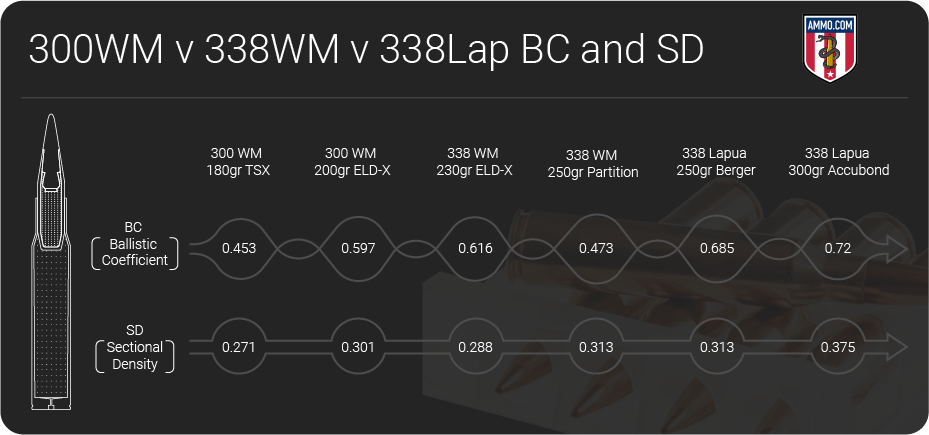
In the table below, we’ve listed the ballistic coefficient and sectional density for our selection of 6 rounds.
As the 338 Lapua is firing longer and heavier bullets, it’s not surprising that has superior BC values compared to the 338 and 300 Win Mag bullets.
For sectional density, the 338 Win Mag and 338 Lapua have about a 20% larger frontal cross-sectional area than the 300 Win mag. To put this in less technical terms, bigger bullets leave bigger holes and therefore cause increased blood loss and tissue damage.
In general, the 338 Lapua will have a greater selection of bullets with higher BC and SD values than the 338 and 300 Win Mag. This is not to suggest that either Winchester round is lacking in wind deflection or penetration, on the contrary, the 338 Win Mag and 300 Win Mag are more than sufficient to handle elk, bears, and even moose. The 338 Lapua simply fires heavier bullets that are less susceptible to wind drift and will penetrate slightly deeper.
300 Win Mag vs 338 Lapua
The 300 Winchester Magnum fires thinner and lighter bullets than the 338 Lapua although both rounds have similar trajectories within normal hunting ranges. The 338 Lapua carries around 20-40% more muzzle energy at the cost of 80% higher felt recoil.
338 Win Mag vs 300 Win Mag
The 338 Winchester Magnum fires wider and heavier bullets than the 300 Win Mag. However, the 300 Win Mag has a slightly flatter trajectory thanks in part to its increased case capacity and muzzle velocity. The 338 Win Mag will have about 15% higher recoil than the 300 Win Mag.
338 Win Mag vs 338 Lapua
Both rounds fire the same diameter bullets although the 338 Lapua Magnum can fire heavier and more aerodynamic bullets than the 338 Win Mag. Typically the 338 Lapua will penetrate deeper, resist wind deflection, and retain its kinetic energy more efficiently than the 338 Win Mag. However, the 338 Win Mag will have lower felt recoil than the Lapua.
Hunting
No matter if you’re hunting whitetail in the Midwest, mule deer in the Great Plains, or elk in the Pacific Northwest or Canada, hunters will tell you that there is no large game animal in North America that can stand up to any of these rounds with proper shot placement.
By far, the most popular hunting round is the 300 Winchester Magnum, as factory ammo is plentiful and bolt-action rifles are easy to come by. The muzzle energy and flat trajectory are incredibly popular with big game hunters and the round offers about half the felt recoil compared to the 338 Lapua. Rifles for 300 Win Mag are typically lighter than their larger caliber counterparts, making a 300 WM rifle easier to carry through thick brush or on long stalks.
The 338 Winchester Magnum often finds itself in the hands of hunting guides in Alaska who are looking to bag Grizzly or moose. The added penetration offered by the 0.338” diameter projectiles gives hunters the stopping power they need for these larger game animals. There’s nothing to say that a 300 Win Mag couldn’t do this job as well, but the 338 Win Mag just does it a bit better and offers hunters added kinetic energy and penetration with only a small increase in recoil.
The 338 Lapua finds itself in an interesting spot when it comes to big game hunting. The Lapua round is more than capable of taking down elk and bears of all varieties from long range. And when dealing with dangerous game, like Kodiak bears or Cape Buffalo, long range is exactly where you want to be. However, many hunters find the 338 Lapua is more cartridge than what they need to get the job done.
The 338 Lapua was originally designed for military sniper rifles, reportedly capable of penetrating NATO body armor at 1,000 yards. On the other hand, the 300 and 338 Win Mag were developed with sportsmen in mind. The punishing recoil of the Lapua round needs to be taken into serious consideration when evaluating it as a hunting cartridge.
Although it might be tempting to just buy a heavier rifle to soak up the added recoil, is it feasible to carry that 15-pound rifle all day through the woods? This is a question that each hunter needs to consider and answer for themselves. Most will conclude that a lighter rifle is preferable and the added ballistic performance of the 338 Lapua isn’t needed for most large game in North America.
Here at Ammo.com, we would never tell you to not get the rifle you want as this is intrinsic to our 2nd Amendment rights, which extends well beyond the scope of just hunting. If you want to take a 338 Lapua hunting, then there’s no reason not to as the round serve you well. Just understand the drawbacks of added rifle weight and recoil when it comes to employing the Lapua cartridge in typical hunting situations.
Ammo and Rifle Cost/Availability
Without question, the 300 Win Mag is the more popular cartridge with numerous hunting factory loads and hunting rifles in every configuration imaginable at your fingertips. Due to its military and long range shooting roots, the 338 Lapua falls in the middle when it comes to ammo and rifle options while the 338 Win Mag is the most difficult to secure of the three.
Due to its popularity and effectiveness against whitetail and mule deer, the 300 Win Mag is the least expensive of the three magnum cartridges, averaging around $2/round for inexpensive practice ammo from Prvi Partizan to $5/round for premium hunting rounds from Nosler, Norma, Berger, Barnes, Remington, and Federal.
The words “inexpensive” are not often uttered when talking about 338 Win Mag and Lapua ammo. Of the two, the 338 Win Mag is the least expensive with hunting ammo costing between $4-5/round on average. As the 338 Lapua is the largest cartridge of the bunch, it commands the highest price, with the least expensive ammo starting around $5/round and the match-grade ammo running $10/round and up.
When it comes to rifles, 300 Win Mag is by far the easier chambering to locate and generally a less expensive rifle to acquire. All the major firearm manufacturers like Remington, Winchester, Savage, Ruger, Browning, and Sako have a bolt-action rifle offering in 300 Win Mag.
The 338 Win Mag and 338 Lapua are also mostly relegated to bolt-action rifles available from most manufacturers. In terms of availability, the 338 Lapua is more common as it is a military caliber and popular with long range shooters. The 338 Win Mag is a bit more obscure but manufacturers like Winchester, Browning, and Savage have bolt-action options for the 338 WM.
If you’re looking for a semi-automatic rifle for these magnum cartridges, there are a few options. The Browning BAR is the most popular option for 300 and 338 Win Mag, although Noreen Firearms and Nemo Arms also have AR-15 style rifles available in 300 Win Mag and 338 Lapua. DRD Tactical and Sword International also have AR-style semi-auto 338 Lapua rifles.
Reloading
There’s no denying that these magnum cartridges are considerably more expensive than other centerfire options like the 223 Remington. Handloading is one option that shooters utilize to help curtail their cost per round.
Handloading is also a great way to manufacture match-grade ammo that is customized to your rifle at a lower cost than factory match ammo.
The 300 Win Mag is a relatively easy cartridge to reload as it fires the same diameter projectiles as the 308 Winchester, 300 WSM, and 30-06 Springfield. In general, 0.308” diameter bullets are easy to source and relatively inexpensive.
Although a bit more expensive, many bullet manufacturers are warming up to the utility of the 338-caliber bullets for hunting. Manufacturers like Hornady, Sierra, Barnes, and Berger have a selection of hunting and match bullets available for reloading, but there are fewer options compared to 0.308” diameter bullets.
For many shooters, reloading is a necessity when shooting 338 WM and 338 Lapua as the high cost of factory ammo is prohibitive. Unless you have a government-sized ammo budget, it might be worth the investment in a solid reloading press and dies if you plan on shooting a lot of 338-caliber rounds.
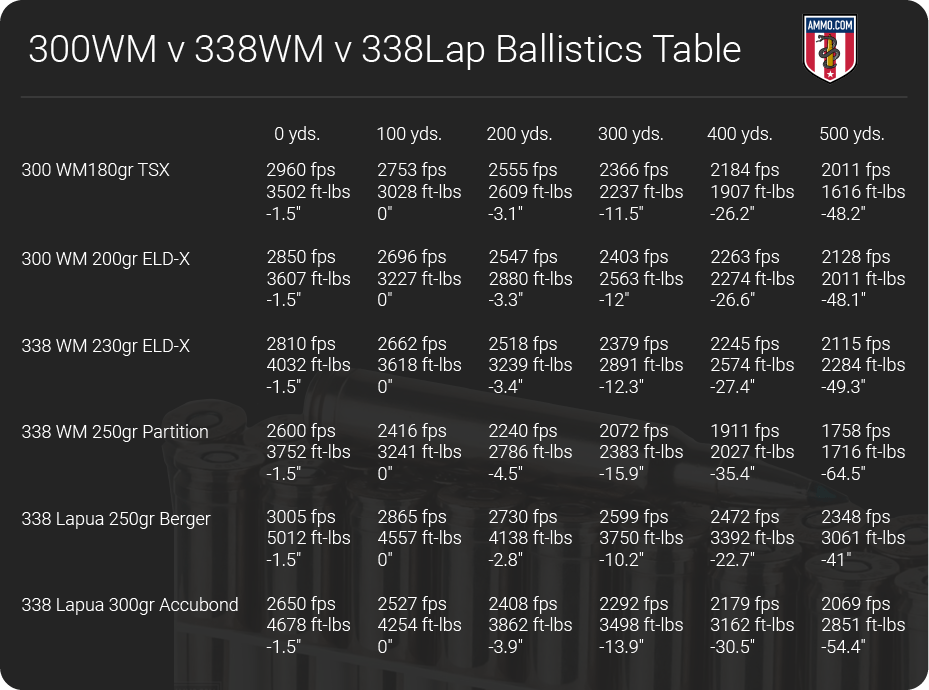
300 Win Mag vs 338 Win Mag vs 338 Lapua Magnum Ballistics
Our team here at Ammo.com has spent countless hours scouring the Internet to bring you extremely comprehensive ballistics tables for both calibers. Below are tables that compare bullet weight to muzzle velocity, kinetic energy, and trajectory for 300 Win Mag vs 338 Win Mag vs 338 Lapua Mag.
300 Winchester Magnum Ballistics
Note: This information comes from the manufacturer and is for informational purposes only. The actual ballistics obtained with your firearm can vary considerably from the advertised ballistics. Also, ballistics can vary from lot to lot with the same brand and type load.
| 300 Win Magnum Bullet WEIGHT | Muzzle VELOCITY (fps) | Muzzle ENERGY (ft. lbs.) | TRAJECTORY (in.) | |||||||||||
|---|---|---|---|---|---|---|---|---|---|---|---|---|---|---|
| Muzzle | 100 yds. | 200 yds. | 300 yds. | 400 yds. | Muzzle | 100 yds. | 200 yds. | 300 yds. | 400 yds. | 100 yds. | 200 yds. | 300 yds. | 400 yds. | |
| 150 Grain | 3290 | 2951 | 2636 | 2342 | 2068 | 3605 | 2900 | 2314 | 1827 | 1424 | 2.5 | 1.9 | -3.8 | -15.8 |
| 150 Grain Superformance | 3400 | 3150 | 2914 | 2690 | 2477 | 3850 | 3304 | 2817 | 2409 | 2043 | 1 | 0 | -5.1 | -15 |
| 165 Grain | 3100 | 2877 | 2665 | 2462 | 2269 | 3522 | 3033 | 2603 | 2221 | 1897 | 2.5 | 2.4 | -3 | -16.9 |
| 178 Grain | 2900 | 2760 | 2568 | 2375 | 2191 | 3509 | 3030 | 2606 | 2230 | 1897 | 2.5 | 1.4 | -5 | -17.6 |
| 178 Grain | 2960 | 2770 | 2588 | 2413 | 2245 | 3463 | 3032 | 2647 | 2301 | 1992 | 1.5 | 0 | -6.7 | -19.4 |
| 178 Grain Super Match | 2960 | 2770 | 2587 | 2412 | 2243 | 3462 | 3031 | 2645 | 2298 | 1988 | 1.5 | 0 | -6.7 | -19.4 |
| 180 Grain | 2960 | 2745 | 2540 | 2344 | 2157 | 3501 | 3011 | 2578 | 2196 | 1859 | 2.5 | 1.2 | -5.5 | -18.5 |
| 180 Grain Superformance | 3130 | 2927 | 2732 | 2546 | 2366 | 3917 | 3424 | 2983 | 2589 | 2238 | 1.3 | 0 | -5.9 | -17.3 |
| 190 Grain | 2885 | 1691 | 2506 | 2327 | 2156 | 3511 | 3055 | 2648 | 2285 | 1961 | 2.5 | 1.2 | -5.7 | -19 |
| 200 Grain | 2825 | 2595 | 2376 | 2167 | 1970 | 3545 | 2991 | 2508 | 2086 | 1742 | -2.5 | 1.6 | -4.7 | -17.2 |
| 220 Grain | 2680 | 2448 | 2228 | 2020 | 1823 | 3508 | 2927 | 2424 | 1993 | 1623 | 2.5 | 0 | -9.5 | -27.5 |
338 Winchester Magnum Ballistics
Note: This information comes from the manufacturer and is for informational purposes only. The actual ballistics obtained with your firearm can vary considerably from the advertised ballistics. Also, ballistics can vary from lot to lot with the same brand and type load.
| 338 Win Magnum Bullet WEIGHT | Muzzle VELOCITY (fps) | Muzzle ENERGY (ft. lbs.) | TRAJECTORY (in.) | |||||||||||
|---|---|---|---|---|---|---|---|---|---|---|---|---|---|---|
| Muzzle | 100 yds. | 200 yds. | 300 yds. | 400 yds. | Muzzle | 100 yds. | 200 yds. | 300 yds. | 400 yds. | 100 yds. | 200 yds. | 300 yds. | 400 yds. | |
| 185 Grain Superformance | 3080 | 2850 | 2632 | 2424 | 2226 | 3896 | 3337 | 2845 | 2413 | 2034 | 1.4 | 0 | -6.4 | -18.8 |
| 200 Grain | 3030 | 2820 | 2620 | 2429 | 2246 | 4077 | 3532 | 3049 | 2621 | 2240 | 1.4 | 0 | -6.5 | -18.9 |
| 210 Grain | 2830 | 2590 | 2370 | 2150 | 1940 | 3735 | 3130 | 2610 | 2155 | 1760 | 2.5 | 1.4 | -6 | -20.9 |
| 225 Grain | 2785 | 2517 | 2266 | 2029 | 1808 | 3871 | 3165 | 2565 | 2057 | 1633 | 2.5 | 0.4 | -8.5 | -25.9 |
| 225 Grain Superformance | 2840 | 2758 | 2582 | 2414 | 2252 | 4318 | 3798 | 3331 | 2911 | 2533 | 1.5 | 0 | -6.8 | -19.5 |
| 230 Grain | 2780 | 2573 | 2375 | 2186 | 2005 | 3948 | 3382 | 2881 | 2441 | 2054 | 2.5 | 1.2 | -6.3 | -21 |
| 250 Grain | 2660 | 2456 | 2261 | 2075 | 1898 | 3927 | 3348 | 2837 | 2389 | 1999 | 2.5 | 0.2 | -9 | -26.2 |
| 250 Grain Ultra | 2860 | 2645 | 2440 | 2244 | 2057 | 4540 | 3882 | 3303 | 2794 | 2347 | 1.7 | 0 | -7.6 | -22.1 |
338 Lapua Magnum Ballistics
Note: This information comes from the manufacturer and is for informational purposes only. The actual ballistics obtained with your firearm can vary considerably from the advertised ballistics. Also, ballistics can vary from lot to lot with the same brand and type load.
| 338 Lapua Magnum Bullet WEIGHT | Muzzle VELOCITY (fps) | Muzzle ENERGY (ft. lbs.) | TRAJECTORY (in.) | |||||||||||
|---|---|---|---|---|---|---|---|---|---|---|---|---|---|---|
| Muzzle | 100 yds. | 200 yds. | 300 yds. | 400 yds. | Muzzle | 100 yds. | 200 yds. | 300 yds. | 400 yds. | 100 yds. | 200 yds. | 300 yds. | 400 yds. | |
| 250 Grain | 2900 | 2685 | 2481 | 2285 | 2098 | 4668 | 4002 | 2416 | 2899 | 2444 | 1.7 | 0 | -7.3 | -21.3 |
| 250 Grain | 2963 | 2795 | 2640 | 2493 | n/a | 4842 | 4341 | 3881 | 3458 | n/a | 1.9 | 0 | -7.9 | 0 |
| 250 Grain Match | 2900 | 2760 | 2625 | 2494 | 2366 | 4668 | 4229 | 3825 | 3452 | 3108 | 1.5 | 0 | -6.6 | -18.8 |
| 285 Grain | 2745 | 2616 | 2491 | 2369 | 2251 | 4768 | 4331 | 3926 | 3552 | 3206 | 1.8 | 0 | -7.4 | -21 |
| 285 Grain Match | 2745 | 2623 | 2504 | 2388 | 2275 | 4768 | 4352 | 3966 | 3608 | 3275 | 1.8 | 0 | -7.3 | -20.8 |
| 300 Grain | 2660 | 2544 | 2432 | 2322 | n/a | 4715 | 4313 | 3940 | 3592 | n/a | 1.9 | 0 | -7.8 | n/a |
Final Shots: 300 Win Mag vs 338 Win Mag vs 338 Lapua Magnum
The 300 Winchester Magnum, 338 Winchester Magnum, and 338 Lapua are three exceptional rifle cartridges that are devastating against large game and are extremely flat shooting.
Selecting the right hunting cartridge depends on your intended purpose and preferences.
The majority of shooters will opt for the 300 Win Mag as it provides the best marriage of power, trajectory, recoil, ammo availability, and lower cost compared to the 338 options.
For hunting big game in Alaska, you might want to give the 338 Win Mag a solid look as it offers enhanced penetration over the 300 WM at only a marginal increase in felt recoil.
The 338 Lapua is excellent for long range target shooting and extremely potent hunting round. Its terminal ballistics are superior to the 300 and 338 Win Mag but it pays for this with extremely powerful recoil.
For most hunting situations in North America, the 300 Winchester Magnum has more than enough cartridge to get the job done. However, if you want more power and penetration, then the 338 Win Mag and 338 Lapua are excellent options.
Regardless of which cartridge you choose, make sure you stock up on ammunition here at Ammo.com and I’ll see you on the range!
Ammo Comparisons
- .308 vs 5.56
- 6.5 Creedmoor vs .308
- .300 Blackout vs .308
- .300 Win Mag vs .308
- .243 vs .308
- .308 vs .30-06
- 7mm-08 vs .308
- .270 vs .308
- 7.62x39 vs .308
- .223 vs .308
- .338 Lapua vs .308
- .380 ACP vs 9mm
- .223 vs 5.56
- .300 Blackout vs 5.56
- 9mm vs 45 ACP
- 9mm vs 40 S&W
- .357 SIG vs 9mm
- 10mm vs 9mm
- 9mm vs 9mm Luger
- .243 vs .270
- .300 Win Mag vs .30-06
- .270 vs .30-06
- .40 vs .45
- 38 Special vs 357
- 9mm vs 40 vs 45
- 5.56 vs 7.62x39
- 338 Lapua vs .30-06
- .30-30 vs .30-06
- 300 PRC vs 338 Lapua
- .30-06 vs 7mm
- 300 Win Mag vs 338 Lapua
- 300 PRC vs 300 Win Mag
- 300 WSM vs 300 Win Mag
- 338 Win Mag vs 338 Lapua
- 12 Gauge vs 20 Gauge
- 10mm vs 357 Mag
- .30-30 vs 7.62x39
- 224 Valkyrie vs 22-250
- 17 HMR vs 22 Mag
- 7.62x39 vs .300 Blackout
- 45 ACP vs 45 Auto
- 45-70 vs 30-30
- 300 Blackout vs 223
- 357 Magnum vs 9mm
- 350 Legend vs 300 Blackout
- 224 Valkyrie vs 223
- 45 ACP vs 38 Super
- 6.5 Grendel vs .308
- 17 HMR vs 22 LR
- 10 Gauge vs 12 Gauge
- 22-250 vs 223
- 45 Colt vs 45 ACP
- 350 Legend vs 30-30
- 5.7x28 vs 223
- 5.7 vs 9mm
- 5.56 vs 5.7
- 22 vs 9mm
- Buckshot vs Birdshot
- 450 Bushmaster vs 308
- 450 Bushmaster vs 223
- Buckshot vs Slug
- 6.5 Grendel vs 5.56 vs 223
- 6mm ARC vs 6.5 Grendel
- 44 vs 45
- 458 SOCOM vs 5.56
- 357 vs 44
- 32 ACP vs 380
- 300 Win Mag vs 338 Win Mag vs 338 Lapua Mag
- 450 Bushmaster vs 458 SOCOM vs 50 Beowulf
- 6mm Creedmoor vs 6.5 Creedmoor
- TMJ vs FMJ
- 44 Special Vs 44 Magnum
- 45 90 vs 45 70
- 6.8 Western vs 6.8 SPC
- 50 Beowulf vs 50 BMG
- 26 Nosler vs 6.5 PRC
- 28 Gauge vs 410
- 6.8 SPC vs 5.56
- 6.8 SPC vs 6.5 Grendel
- 6.8 Western vs 7mm Rem Mag vs .28 Nosler
- 6.8 Western vs 6.5 Creedmoor
- 22 Hornet vs 223
- 6.8 Western vs 6.5 PRC
- .410 vs 12 Gauge
- .410 vs 20 Gauge
- 22 LR vs 22 Mag
- 6mm ARC vs 243
- 7mm-08 vs 270
- 243 vs 6.5 Creedmoor
- Nickel vs Brass Casing
- 204 Ruger vs 223
- 50 Beowulf vs 5.56
- 260 Remington vs 6.5 Creedmoor
- 6mm Remington vs 243
- 28 Nosler vs 300 PRC
- 50 Beowulf vs 50 AE
- 22 Nosler vs 22-250
- 450 Marlin vs 45-70
- 300 Win Mag vs 300 Norma
- 458 SOCOM vs 300 Blackout
- 38-55 vs 45-70
- 22 Hornet vs 22 LR
- 300 Norma vs 338 Lapua
- 338 Lapua vs 50 BMG
- 28 Nosler vs 300 Win Mag
- 28 Nosler vs 6.5 Creedmoor
- 204 vs 22-250
- 458 SOCOM vs 45 70
- 44 40 vs 45 70
- 6.8 SPC vs 6.5 Creedmoor
- 450 Bushmaster vs 30-06
- 7mm Rem Mag vs 300 Win Mag
- 30 Carbine vs 223
- 25-06 vs 30-06
- 26 Nosler vs 28 Nosler
- 16ga vs 12ga
- 30 06 vs 7.62 x54R
- 9mm Makarov vs 9mm Luger
- 350 Legend vs 223
- 30 Carbine vs 5.56
- 6.5x55 vs 6.5 Creedmoor
- 6.5 Creedmoor vs 270 vs 25-06
- M193 vs M855
- 450 Bushmaster vs 458 SOCOM
- 6.5 Grendel vs 6.5 Creedmoor
- 350 Legend vs 5.56
- .277 Fury vs 6.8 SPC
- 277 Fury vs 300 Win Mag
- 10mm vs .45 ACP
- 277 Fury vs 223
- 6.8 SPC vs 300 Blackout
- 6.5 PRC vs 6.5 Creedmoor
- 277 Fury vs 308
- 277 Fury vs 6.5 Creedmoor
- 350 Legend vs 450 Bushmaster
- 277 Fury Vs 5.56 NATO
- 10mm vs 40S&W
- 32 ACP vs 9mm
- 32 Special vs 9mm
- 8.6 Blackout vs 300 Blackout
- 30 Super Carry vs. 9mm
- 5.56 vs 9mm
- .50 Action Express vs 9mm
- 7.62x25 vs. 9mm
- 10mm vs 44 Magnum
- 300 Blackout vs 300 Win Mag
- 6.5 Grendel vs 300 Blackout
- 460 Rowland vs 10mm
- 300 RUM vs 300 PRC
- 300 Norma vs 300 PRC
- 45 GAP vs 45 ACP
- 7mm PRC vs 300 Win Mag
- 300 PRC vs 6.5 Creedmoor
- 300 PRC vs 308
- 357 SIG vs 357 Mag
- 7.62x39 vs 7.62x51
- 243 Win vs 223 Rem
- 30 Nosler vs 300 PRC
- 6.5 Creedmoor vs. 30-06 Springfield
- 450 S&W vs. 44 Magnum
- 6.5 Creedmoor vs. 300 Win Mag
- 454 Cassull vs. 45-70 Govt
- 454 Cassull vs. 44 Mag
- 7.62x54r vs. 308 Winchester
- 22 ARC vs. 223 Rem
- Subsonic vs. Supersonic Ammo
